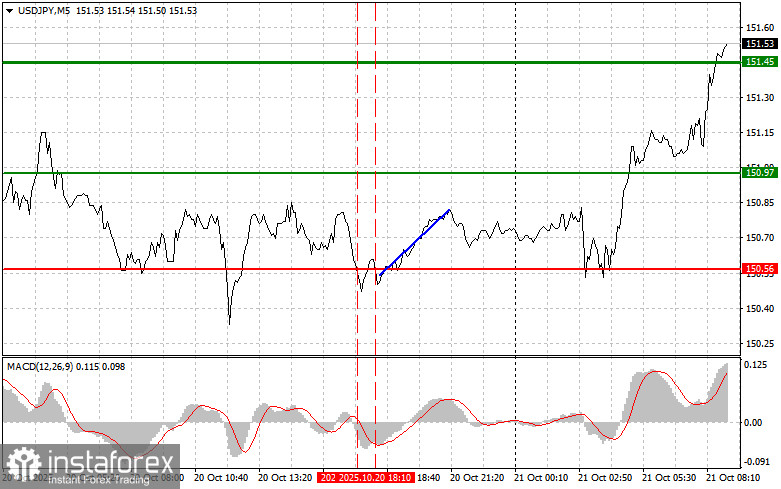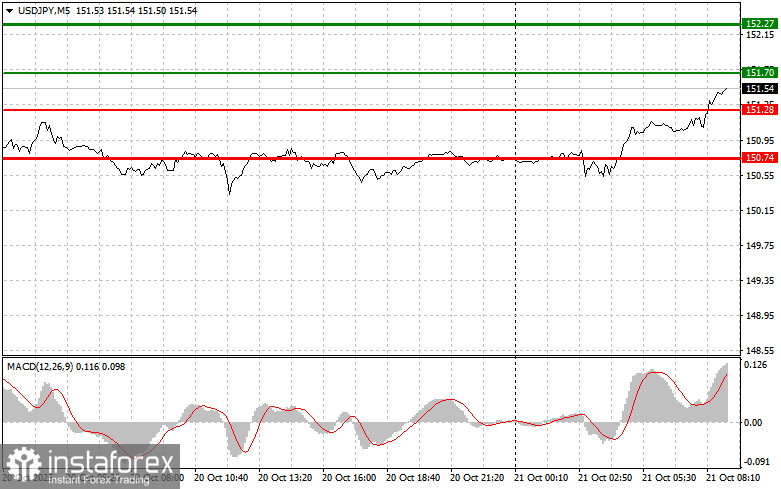Trade Review and Strategy for the Japanese Yen
The test of the 150.56 level occurred while the MACD indicator had already moved significantly below the zero line, which limited the pair's downside potential. Shortly after, another test of 150.56 coincided with the MACD entering oversold territory, which enabled the execution of Buy Scenario 2, resulting in a 25-pip upward move in the pair.
The U.S. dollar continues to recover its losses against the Japanese yen, following last week's decline that was triggered by the Federal Reserve's extraordinarily dovish tone and escalating U.S.-China trade tensions. Investors are now reassessing the outlook for U.S. interest rates, recognizing that even with ongoing dovish rhetoric, persistently high inflation may force the Fed to act more cautiously in the coming months.
Furthermore, the absence of new economic data from the United States supports safe-haven demand for the dollar—particularly relevant given the persistent geopolitical tensions and renewed concerns about a global economic slowdown tied to U.S.-China relations.
Meanwhile, the Japanese yen remains under pressure due to the ultra-loose fiscal and monetary policies being backed by the new Japanese prime minister. The government's focus on stimulating domestic growth makes it more likely that the Bank of Japan will need to coordinate by maintaining accommodative monetary policies.

Buy Scenarios
Scenario 1: Buy USD/JPY upon reaching the entry point at 151.70 (green line), with an upside target at 152.27 (thick green line). At 152.27, exit long trades and consider opening short positions on a potential pullback. This trade setup expects a 30 to 35-pip reversal from the resistance zone. Best entries occur on corrective pullbacks or strong dips in USD/JPY.
Important: Before entering a buy trade, confirm that the MACD indicator is above the zero line and just beginning to rise.
Scenario 2: Also consider long entries after two consecutive tests of the 151.28 level if the MACD is in oversold territory. This would suggest limited downside momentum and potential for a reversal toward 151.70 and 152.27.
Sell Scenarios
Scenario 1: Sell USD/JPY if price breaks and consolidates below 151.28 (red line), targeting a move to 150.74 (thick red line). Exit short positions at 150.74 and consider opening long trades on a technical rebound, targeting a 20 to 25-pip recovery. Ideal sell levels are as high as reasonably possible.
Important: Before selling, ensure the MACD is below the zero line and just starting to move lower.
Scenario 2: Also consider selling after two consecutive tests of the 151.70 level if the MACD is in overbought territory. This limits bullish continuation and may lead to a reversal toward 151.28 and 150.74.

Chart Key Explanations
- Thin green line – approximate entry point for long positions
- Thick green line – suggested Take Profit level or area to secure gains, as growth above this point is unlikely
- Thin red line – approximate entry point for short positions
- Thick red line – suggested Take Profit level or area to secure gains, as further decline is unlikely
- MACD Indicator – use overbought/oversold conditions to guide entry decisions
Important Note for Beginner Traders
If you are just starting out in Forex, exercise extreme caution when entering the market. It is safest to stay out during the release of major fundamental news to avoid being caught in sharp price swings. If you decide to trade during news events, always set Stop Loss orders to limit potential losses. Not placing Stop Loss orders can lead to rapid account depletion, especially if you don't apply proper money management techniques or trade with overly large positions.
Remember, successful trading requires a clear and structured plan like the one outlined above. Spontaneous decisions based on short-term market noise are a losing strategy for intraday traders. Stick to your plan, manage your risk, and only enter the market when conditions match your criteria.





















